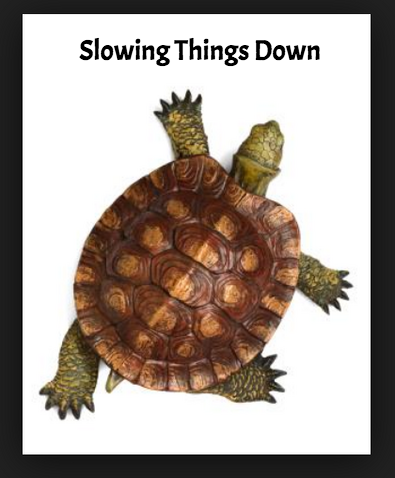
Time doesn't really exist in comics. Someone can blast through multiple pages in seconds, or linger on one panel for years. Well, that would be rare. But you see what I'm saying.
What if you want to make your readers slow down? To give your pages the pace you want?
No Talkie
We may have discussed this around the site, but the first and simplest way to do it is to eliminate the dialogue on a panel or page. This forces the reader to, well, not read. They have to look at the pictures to absorb what's going on. This often slows things down.
Well, not necessarily; a wordless page of action packed panels might feel fairly fast paced. But it will still create more immersion in what's going on.
More Detail
This is the same idea. If a picture has more detail, it can cause the eye to wander around the page, absorbing everything in the panel, especially if the effort is bolstered by a lack of dialogue.
Aspect to Aspect
This type of panel transition is covered in Scout Mcloud's Understanding Comics/Making Comics books. Several panels, showing different aspects of the scene, can slow things right down as well as pulling readers into the environment. Imagine a scene inside a restaurant…(no, I'm not gonna draw it! Who has that kinda time??)
INTERIOR, RESTAURANT
Panel One: A couple at a table, laughing
Panel Two: Two wine glasses clink together
Panel Three: Closeup of a knife slicing into a steak
Panel Four: A waiter walks along, tray in hand
Panel Five: …
…Etcetera. Moving aspect to aspect can slow things down, even with smaller panels.
Borderless
A borderless panel that has no “frame”, with the image going to the edge of the page (literal or web page), can again force the reader to slow down and take it all in, whereas framed panels will tend to be taken in more quickly.
These are the techniques that come to mind to slow down time in a comic. They can be used in combination, especially with the no dialogue (or minimal dialogue) thing. Too much dialogue might keep the focus on the words and make it less likely the reader will slow down.
Or that's my theory at least.
Have you used techniques like this to slow things down or create a deeper connection to what's going on in your comic? Are there other techniques you think would work?
See you next time!
take ‘er slow, y’all!
-Banes
From the Best of Banes Collection

Time Stand Still
Banes at 12:00AM, Nov. 8, 2018
4 likes!


©2011 WOWIO, Inc. All Rights Reserved Mastodon





PaulEberhardt at 5:42PM, Nov. 10, 2018
I've never thought that much about panel shape or border widths, but I think I use them instinctively. Or at least I damn well should, because it makes perfect sense to. The thing is, I usually dispense with clear panel borders so as to create a sense of flow, but the speed of that flow still depends very much on how tightly you pack the panels together and whether your eyes can follow them in a straight line or need to move across the page in a more fengshui-like way in a manner of speaking.
PaulEberhardt at 5:37PM, Nov. 10, 2018
My favourite technique has got to be the detail and camera angle tactic, and by that I don't necessarily mean how much you put in a panel in the first place, but simply how many things change between panels. In my experience you can slow down the pace spectacularly by keeping up the same pedestrian camera angle for several panels and changing just one or two small (but relevant!) details of a plethora to choose from. Vice versa, e.g. when the gag kicks in, doing the exact opposite, i.e. less details, more action, different angle (perhaps tilt the panel a bit to get a hand camera effect) will catapult everything into full throttle. The contrast to the slower parts plays an important part as well, there.
AmeliaP at 6:59PM, Nov. 9, 2018
I totally agree with your theory, plus @Usedbooks. Layout makes the difference because it determines the rhythm. The camera view inside a panel too, not only the panel format. Imagine a horizontal panel. It has a train in side view far from the viewer. Now, imagine the same horizontal panel with a train in an exploded perspective going towards the viewer, from background to foreground. The things speed up, right? It's a combination of panel format, size, camera view, character and background composition and dialogue (or the lack of speech). It can vary with the art style as well. In Noir style, that I'm studying, they speed up or slow down time using shadows as part of the frame/panel.
Ozoneocean at 8:51PM, Nov. 8, 2018
Interesting point about the framelesness and Usedbook's comment about the panel aspect. Another thing is border width or "gutters". You change the width of them to change pace and time. Wider borders equal a longer time between panels and vice versa.
usedbooks at 12:49PM, Nov. 8, 2018
Panel shape can affect perception of time and mood a great deal too. Vertical panels are dramatic, especially if narrow. Wide, short panels can create a sense of calm (or even pensiveness). You can use that edgeless effect you mentioned to accentuate it. Panels put at an angle are active and will throw off the sense of balance and force the reader to feel urged forward more quickly. If you think of the panel layout like building blocks, you can get an idea for how stable or unstable, slow or active, they can feel. In addition, you can use extreme close-ups or wide-angles depending on the mood of the "slow" scene (close-ups are tense, wide-shots are more desolate or calm).